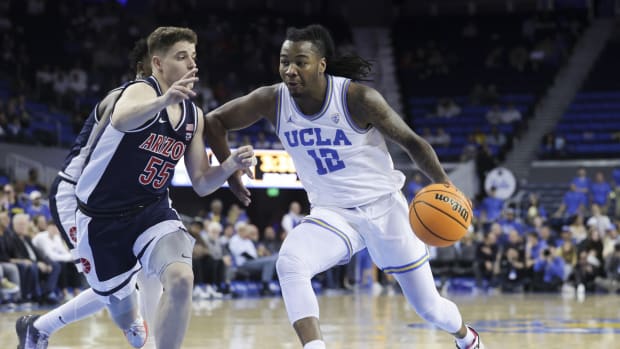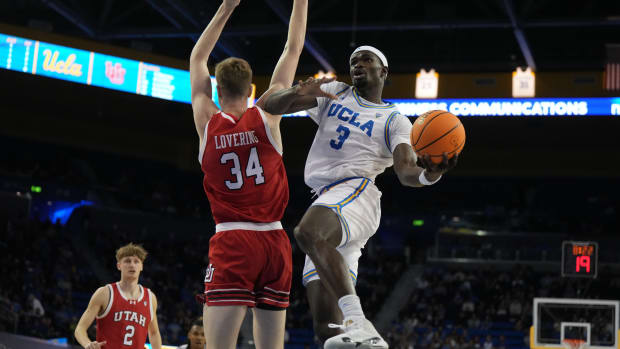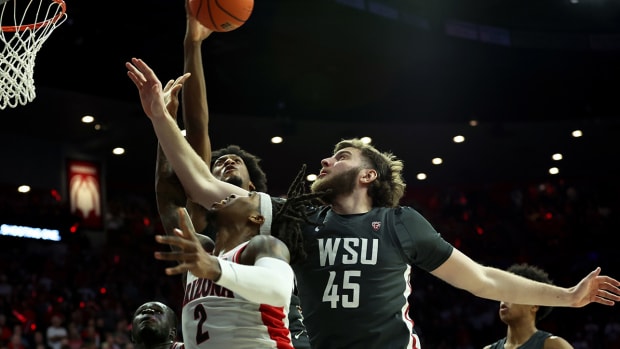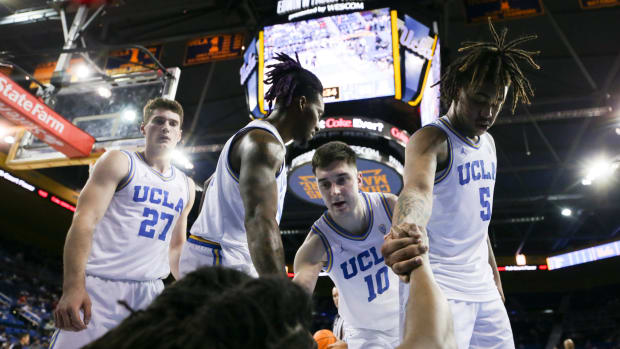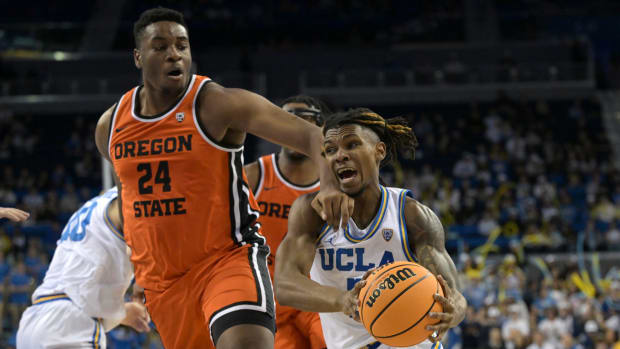Pac-12 Men's Basketball Media Day: Commissioner George Kliavkoff Details 'The Alliance'
The Pac-12 had quite the run last March.
Despite not having a single team in the NCAA tournament awarded a No. 4 seed or better, the conference wound up sending four teams to the Sweet 16, three to the Elite Eight and one to the Final Four in UCLA men's basketball. Commissioner George Kliavkoff and deputy commissioner Jamie Zaninovich rattled off stat after stat about their conference's success this past spring at Pac-12 Men's Basketball Media Day on Wednesday, giving special credence to the show the Bruins put on down the stretch, even if it ended in a buzzer-beater defeat.
"I'll apologize to Mick (Cronin) later, I had to bring it up," Zaninovich said.
So it only makes sense for other conferences to want to hitch their wagon to the Pac-12 after seeing what went down in March Madness last year – also taking into account Stanford and Oregon playing head-to-head in the women's NCAA tournament finals, of course.
"The Alliance" is a unification of the Pac-12, ACC and Big Ten. When it was officially announced by the three conference commissioners back in August, what exactly it constituted was still very much up in the air.
Kliavkoff gave some additional insight into what he sees as the biggest goals of the agreement on Wednesday, however, even if the partnership technically isn't in writing.
The three main goals, according to Kliavkoff, are as follows: Provide additional support for the student athletes; work towards making a positive impact on the future of college sports; create new excitement for fans through creative scheduling and the creation of new college sports events.
In terms of how he thinks the grouping together of the three independent conferences could help the student-athletes, Kliavkoff said it's mostly about creating an open line of discussion and sharing ideas across conference lines to work towards the best solutions.
"That means for leadership training, diversity-equity inclusion, mental-physical health," Kliavkoff said. "All of the things that we do support our athletes in the Pac-12, we want to take our best practices, share them with the Big Ten and ACC and have them share with us their best practices."
Kliavkoff also clarified an assumption many made about "The Alliance" when it was initially announced.
While they aim to puts their heads together and establish similar priorities surrounding NCAA policies and bylaws, the 41 combined member institutions are not going to be forced to vote as a singular mass that can automatically outweigh the powers in the SEC and Big 12.
"It's not a voting block, we've not agreed to vote together," Kliavkoff said. "It's an agreement to discuss and try and push forward what's right for college athletics in the long term when we're thinking about the solutions to those issues."
All of that clerical work and pencil-pushing aside, most fans are really looking forward to "The Alliance" for one reason.
Scheduling.
"That's the one that gets the most attention, but it's the third priority out of the three," Kliavkoff said.
Kliavkoff has recently mentioned preseason and midseason tournaments as options for how to utilize the scheduling power of "The Alliance" in basketball. He confirmed Wednesday that there were no announcements to be made in terms of anything concrete that has come together though.
Zaninovich said there are several men's basketball matchups already in place between "Alliance" teams as part of previously scheduled nonconference tournaments, and that the Pac-12 plans to release promotional marketing material surrounding those matchups in the near future.
Playing more high-major teams more consistently is going to be a good thing for future tournament seeding, Zaninovich said, and as a result, the perception of the conference moving forward.
"Listen, at the end of the day, our seeding will likely be determined – and selection in that respect – in November and December," Zaninovich said. "What you want are games in the nonconference that are only upside games. We want to play as many games that, win or lose – if you lose, they're a quality team and it doesn't hurt you, if you win, it's gonna help you when they're talking about that seed line."
UCLA didn't need "The Alliance" to boost its strength of schedule this year.
Gonzaga, North Carolina, Villanova, Marquette and UNLV are all on the nonconference slate, giving the Bruins arguably the toughest and most entertaining schedule in the Pac-12, if not the country.
Regardless, UCLA is set to join "The Alliance" with 40 other schools, and it's impact on the hardwood could be right around the corner.
Follow Connon on Twitter at @SamConnon
Follow All Bruins on Twitter at @SI_AllBruins
Like All Bruins on Facebook at @SI.AllBruins
Subscribe to All Bruins on YouTube
Read more UCLA stories: UCLA Bruins on Sports Illustrated
Read more UCLA men's basketball stories: UCLA Men's Basketball on Sports Illustrated

